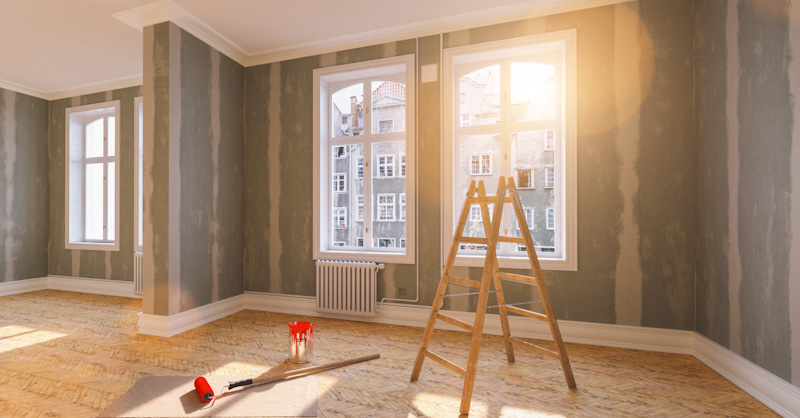Drywall Installment Facilitated: Tips for Perfect Outcomes
Drywall installation is usually regarded as an overwhelming task, yet with the right technique and understanding, it can become a workable endeavor. Understanding techniques for cutting, hanging, and finishing drywall can significantly influence the end result.
Choosing the Right Materials
Selecting the suitable materials for drywall setup is crucial to achieving a resilient and visually pleasing coating. drywall contractor. The primary element, drywall sheets, commonly can be found in various densities, with 1/2-inch sheets being common for interior wall surfaces. For locations needing added dampness resistance, such as restrooms or kitchens, think about making use of environment-friendly board or cement board, which are specifically created to stand up to humidity

Preparing the Installment Location
Before starting the drywall installment procedure, it is crucial to prepare the installment location thoroughly. A tidy work area minimizes the threat of damages to existing things and allows for efficient activity throughout installation.
Following, examine the wall surfaces and ceiling for any kind of imperfections, such as splits, holes, or mold and mildew. Address these concerns ahead of time; patch any kind of damages and allow sufficient time for repairs to dry. Additionally, make sure that electric outlets, switches, and plumbing are properly placed and accounted for, as this will impact drywall placement.
Think about the environmental conditions. A stable temperature and humidity level are important for ideal bond and performance of the drywall materials. Utilize a dehumidifier or heating unit to produce appropriate conditions. if required.
Cutting and Hanging Drywall
The key to efficient drywall installation hinges on the specific cutting and dangling of the panels. Begin by measuring the area accurately, taking into account any blockages such as electric outlets or home windows. Utilize a straight edge and an utility knife to rack up the drywall along your dimensions, then snap it along the racked up line for a tidy break. For more elaborate cuts, such as around outlets, a drywall saw can be utilized for accuracy.

Constantly function from the top down and delegated right, ensuring that you preserve a staggered pattern to boost stability. Effectively hanging the drywall sets the structure for a smooth coating, eventually bring about exceptional outcomes in your drywall task.
Taping and Mudding Strategies
While proper cutting and hanging of drywall establishes the phase, the next important action involves grasping taping and mudding strategies to make certain a smooth finish. Insulation is necessary for strengthening joints and protecting against cracks; it entails embedding tape into the applied joint substance (mud) Beginning with a quality fiberglass or paper tape, applying the tape over the joint and pushing it into the damp mud making use of a taping knife, guaranteeing explanation no air bubbles stay.
When the tape remains in area, use a thin layer of joint compound over the tape, feathering the edges to produce a smooth shift to the drywall surface area. Permit this layer to completely dry entirely prior to sanding it gently to get rid of imperfections. Repeat this process, applying additional coats of mud as required-- normally 2 to 3 layers-- while progressively expanding the application location with each layer to attain a smooth appearance.
After the last layer dries out, sand the surface with a fine-grit sandpaper until smooth. sheetrock repair fort worth. Bear in mind to put on a mask throughout fining sand to prevent inhaling dust particles. Mastering these taping and mudding methods is important for attaining a professional-quality surface in your drywall setup
Finishing Touches for Perfection
Attaining a remarkable drywall installment learn the facts here now goes past taping and mudding; it culminates in the finishing touches that boost the total look. These final steps are critical in making certain a professional-grade coating that improves the aesthetic appeals of your space.
Begin by sanding the dried out joint compound to create a smooth surface area. Utilize a fine-grit sandpaper and a sanding block or post sander for ideal control. Pay particular focus to edges and edges, as these locations often tend to require even more precise work. After fining sand, wipe down the wall surfaces with a damp towel to eliminate any dirt particles, making certain a clean surface area for painting.
Next, apply a guide particularly developed for drywall. This action is essential, as it aids seal the joint substance and gives an uniform base for the overcoat. As soon as the guide dries, examine for any kind of imperfections, and retouch as required.
Conclusion
In conclusion, effective next page drywall installment pivots on the careful selection of materials, comprehensive preparation of the setup area, and exact implementation of reducing and hanging strategies. Proficiency of taping and mudding procedures is crucial for attaining a smooth coating.
Drywall installment is often perceived as a challenging job, yet with the right approach and knowledge, it can come to be a convenient undertaking.Picking the proper products for drywall setup is critical to attaining a sturdy and cosmetically pleasing surface.Before beginning the drywall installment procedure, it is necessary to prepare the setup area thoroughly. Understanding these taping and mudding methods is important for accomplishing a professional-quality finish in your drywall installment.
In verdict, successful drywall installation hinges on the careful selection of products, complete preparation of the installation location, and accurate execution of reducing and hanging strategies.
Comments on “Specialist Sheetrock Repair Fort Worth for Quick Fixes”